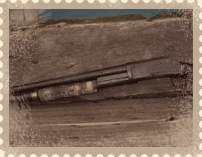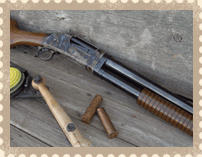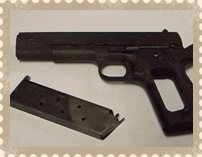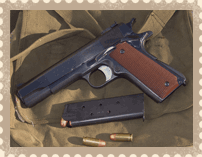At Run-N-Iron Customizing, we feel that almost all old firearms are restorable.
Whether it's your favorite shotgun that has worked hard through hundreds of goose
blinds, your great-grandfather's old rusty saddle gun that tamed the west or a family
heirloom that was scorched in a fire, we can restore it to look and operate as though
it just rolled off the factory assembly line. If collector grade firearms are more
your interest, we can turn your old standard Winchester 1886 into a presentation
showpiece like those of cattle barons and the wealthiest aristocrats.
When restoring a piece of history, the biggest problem is rust. The key to removing
rust without damaging the original contour of a gun is in the sanding. We remove
all rust pits through block sanding by hand. This prevents the common "rounded
edge" effect that occurs when rust is removed using a buffing wheel. Time
and pricing fluctuate with the degree of rust. As for serial numbers and lettering
(including insignias), the factory markings will still be strong enough in most
instances to be re-sharpened through the block sanding process. However, when rust
has overtaken the factory lettering, the metal is sanded clean and new lettering
is cut using a diamond laser engraver. We have the ability to duplicate most all
original markings. For an additional fee, lettering can be re-stamped using original
roll stamps.
Another consequence of long years of hard use is worn and pitted rifling. We
offer two options for restoring the accuracy of your firearm. The first option
is a barrel liner. We drill out the original barrel, install a new liner, chamber
it, and then cut the crown. The second option is to install a new barrel. We can
match the original configuration or build a custom barrel to your specifications.
With any new barrel, we crown and chamber it, install the sights and cut lettering
to duplicate the factory markings on the original barrel.
To make your restored firearm function properly, we repair or replace all broken
parts and build up parts that are worn. We also tune the action to make it operate
even smoother than when it was new.
The last feature in restoring an old firearm is the stock. We begin refinishing
a stock by removing all fittings and attachments such as the sling swivels, pistol
grip cap and butt plate. The next step is to remove the existing finish. When
refinishing a gunstock, the composition of its original finish will influence the
method best suited for removing it, whether the process use special solvents, ordinary
paint remover, acetone, methyl ethylketone or chlorinated solvents such as trichloroethylene
and perchloroethylene. A water diluted solvent such as acetone is then used as
a final rinse, which will later aide drying of the wood. Next, dents and handling
marks are raised by steaming them out with a hot iron. Once the stock has completely
dried (24 to 48 hours), the wood is lightly sanded with 220, 240, 320, 400, and
finally 600 grit sandpapers to remove all scratches. If necessary, a color stain
is then applied, allowed to dry and lightly sanded with 600. A sealer is applied
next, which fills and accentuates the color and grain of the wood. We proceed by
sanding again with 600 and 800, then five to eight coats of high quality varnish,
which is sanded between each coat. To obtain a satin finish, the final rubbing
can be applied with pumice. Several applications of stock wax add protection.
For a more traditional oil finish, we use a combination of boiled linseed oil, truoil
and tung oil. This more traditional method is rubbed into the wood and provides
a far superior appearance to the usual hastily applied factory finish.
If the original stock damaged beyond repair, we will fit your firearm with a new
block of wood. In addition, we can turn your standard gun into a presentation showpiece
with a block of exhibition or crotch-grade walnut stock. New stocks are finished
using the same methods discussed above.
Firearms need to be "cooperative". No one can take a gun that's in 10% condition and make it 100% original condition.
|

BEFORE

AFTER

BEFORE

AFTER
|



